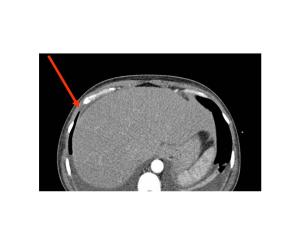A rare connection: the liver and the pelvis
CLINICAL CASE: A 32-year-old woman went to the hospital with pain on her right upper abdominal quadrant, without fever, vomiting or a change in her intestinal habit. She had similar episodes in the last two years without a clear diagnosis. Physical examination showed abdominal distension and tenderness in the right upper abdominal quadrant. A sonogram showed nor cholecystitis or gallbladder stones but a moderate amount of ascites around the liver and pelvis.
What are your suggestions?
[polldaddy poll=9048685]
EVOLUTION: A gynecological examination showed vaginal discharge with signs of infection. A CAT scan(shown here) detected ascites in the pelvic area and perihepatic. Blood test were normal including liver enzymes. X-ray showed a mild bilateral effusion, Ca 125 marker was normal. The patient started with antibiotics with a clear improvement and a total recovery.
FINAL DIAGNOSIS: Pelvic inflammatory disease with perihepatitis (Fitz-Hugh-Curtis syndrome).
COMMENT: In the clinical reasoning process several estrategies are used to select the best possible option based on the signs and symptoms. One is the anatomical-pathophysiologic, or in other words, the reasoning based in our knowledge about how the body works, making connections between different anatomical systems or explaining laboratory findings. But unfortunately this is not always the perfect solution. Some pathological entities challenge our way of thinking and only the recognition of an uncommon pattern could help to solve the problem. What is the connection between a pelvic inflammatory disease (PID)and the liver capsule, responsible for the perihepatitis syndrome associated with PID? In this situation the electronic tools developed to suggest possible diagnoses are very useful because they include uncommon diseases very rare in clinical practice that can be missed.




